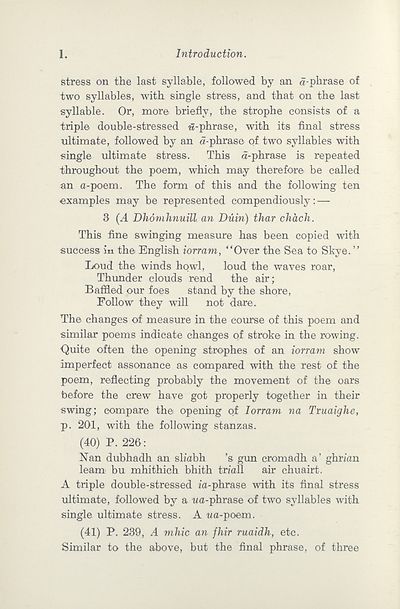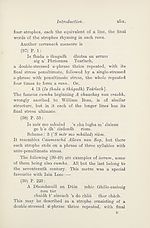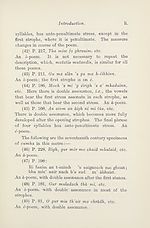Download files
Complete book:
Individual page:
Thumbnail gallery: Grid view | List view

Introduction.
stress on the last syllable, followed by an a-phrase of
two syllables, with single stress, and that on the last
syllable. Or, more briefly, the strophe consists of a
triple double-stressed w-phrase, with its final stress
ultimate, followed by an a-phrase of two syllables with
single ultimate stress. This a-phrase is repeated
throughout the poem, which may therefore be called
an a-poem. The form of this and the following ten
examples may be represented compendiously: —
3 (^4 Dhomhnuill an Duin) thar chdch.
This fine swinging measure has been copied with
success iu the English iorram, “Over the Sea to Skye.”
Loud the winds howl, loud the waves roar,
Thunder clouds rend the air;
Baffled our foes stand by the shore,
Follow they will not dare.
The changes of measure in the course of this poem and
similar poems indicate changes of stroke in the rowing.
Quite often the opening strophes of an iorram show
imperfect assonance as compared with the rest of the
poem, reflecting probably the movement of the oars
before the crew have got properly together in their
swing; compare the opening of lorram na Truaighe,
p. 201, with the following stanzas.
(40) P. 226:
Nan dubhadh an sh'abh ’s gun cromadh a’ ghn'an
learn bu mhithich bhith triall air chuairt.
A triple double-stressed ia-phrase with its final stress
ultimate, followed by a •ua-phrase of two syllables with
single ultimate stress. A ua-poem.
(41) P. 239, A mhic an fhir ruaidh, etc.
Similar to the above, but the final phrase, of three
stress on the last syllable, followed by an a-phrase of
two syllables, with single stress, and that on the last
syllable. Or, more briefly, the strophe consists of a
triple double-stressed w-phrase, with its final stress
ultimate, followed by an a-phrase of two syllables with
single ultimate stress. This a-phrase is repeated
throughout the poem, which may therefore be called
an a-poem. The form of this and the following ten
examples may be represented compendiously: —
3 (^4 Dhomhnuill an Duin) thar chdch.
This fine swinging measure has been copied with
success iu the English iorram, “Over the Sea to Skye.”
Loud the winds howl, loud the waves roar,
Thunder clouds rend the air;
Baffled our foes stand by the shore,
Follow they will not dare.
The changes of measure in the course of this poem and
similar poems indicate changes of stroke in the rowing.
Quite often the opening strophes of an iorram show
imperfect assonance as compared with the rest of the
poem, reflecting probably the movement of the oars
before the crew have got properly together in their
swing; compare the opening of lorram na Truaighe,
p. 201, with the following stanzas.
(40) P. 226:
Nan dubhadh an sh'abh ’s gun cromadh a’ ghn'an
learn bu mhithich bhith triall air chuairt.
A triple double-stressed ia-phrase with its final stress
ultimate, followed by a •ua-phrase of two syllables with
single ultimate stress. A ua-poem.
(41) P. 239, A mhic an fhir ruaidh, etc.
Similar to the above, but the final phrase, of three
Set display mode to:
![]() Universal Viewer |
Universal Viewer | ![]() Mirador |
Large image | Transcription
Mirador |
Large image | Transcription
| An Comunn Gàidhealach > An Comunn Gàidhealach Publications > Bardachd Ghaidhlig > (54) |
|---|
| Permanent URL | https://digital.nls.uk/126281780 |
|---|
| Description | This contains items published by An Comunn, which are not specifically Mòd-related. It includes journals, annual reports and corporate documents, policy statements, educational resources and published plays and literature. It is arranged alphabetically by title. |
|---|
| Description | A collection of over 400 items published by An Comunn Gàidhealach, the organisation which promotes Gaelic language and culture and organises the Royal National Mòd. Dating from 1891 up to the present day, the collection includes journals and newspapers, annual reports, educational materials, national Mòd programmes, published Mòd literature and music. |
|---|---|
| Additional NLS resources: |
|

